Carl Zeiss Turmon
Das Turmon 8x21 wurde von Carl Zeiss Jena seit 1921 hergestellt. |
The Turmon 8x21 was made by Carl Zeiss Jena since 1921. There were different model series during the years – on the left is an original Carl Zeiss Jena pre-war version with serial number 1639696 (between 1935 a. 1937) and with brass body with shrink lacquer; others (quite early) with "F 8x21" golden-yellow markings ('F' msotl ikely stands for "Fernrohr" = "telescope") and has a smooth black finish, thicker prism mounting plates and a slightly longer eye piece, e.g. No 1200625 or see below S/N 1201864 ~ 1923); third: first coated GDR post-war model with classical design, but with plastic prism covers of which their finish imitates the shrink lacquer – serial number (here: 2651146) is engraved with embossed numbers in a stretched oval; fourth: a later GDR Turmon with 1Q sign, redish coated optics and plastic covers – there is no serial number any more; on the right: export model with metal decorative bands (also VEB Carl Zeiss Jena), blue coated and marked "1Q" as well as "aus Jena" (= from Jena). A further model (ser.nr. 1661780, 1935) is marked "Germany", another "Made in Germany" on one side of the prism cover showing that this was an export model. |
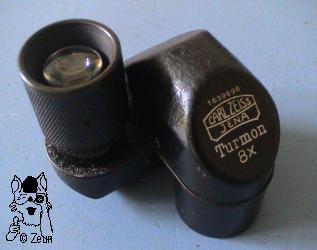
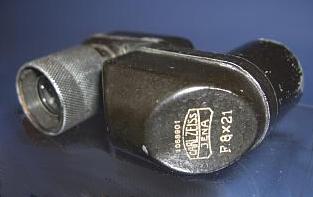

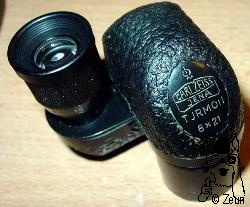
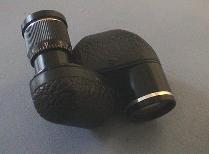
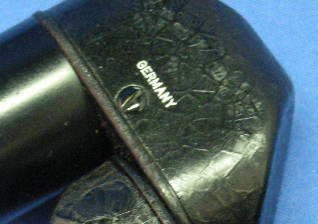
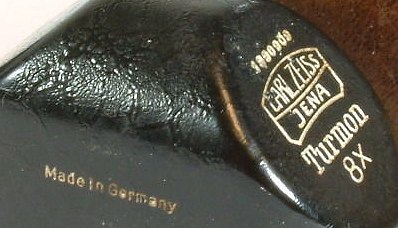
So sind auch die Beschriftungen etwas unterschiedlich: |
The markings are different, too: |

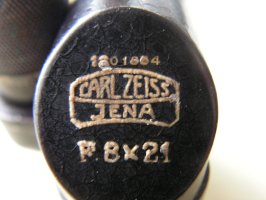
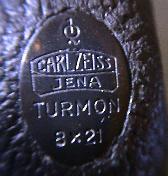

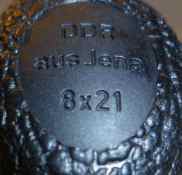
Es wurde mit einer passenden Ledertasche geliefert. |
It came with a fitting leather case. The psot-war models came with a leatherette case and a cardboard sales box with a picture of stylized figures. Thee were typical for Zeiss at that time. (cf. also catalogue clips: 1920er, 1940 (collage), 1950er) |
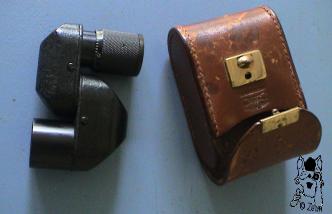
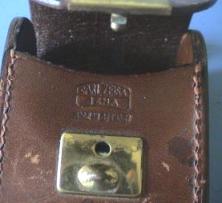
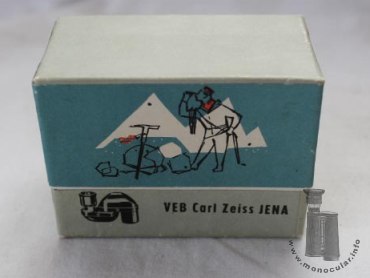
|
Die optischen Werte entsprechen ungefähr den heutigen 8x21 Faltmonokularen: Vergrößerung 8fach; Objektivdurchmesser 21mm; Austrittspupille 2,6mm; Lichtstärke 6,76; Sehfeld 110m oder 6,3°/1000m. Das Turmon zeichnet sich durch einen sehr großen Bereich im Dioptrienausgleich (+ 30 /- 15) aus und erreicht auch einen Nahfokus von knapp über 1m. |
Optical specifications are similar to today's 8x21 folding monoculars: magnification:8; objective 21mm; exit pupil 2.6mm; brightness: 6.76; f.o.v.: 110m/100m or 6.3°. A special feature of the Turmon is its wide dioptre range (+30 / -15). It has a close focus of about 1 meter. |
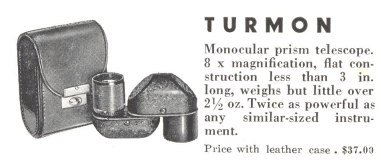


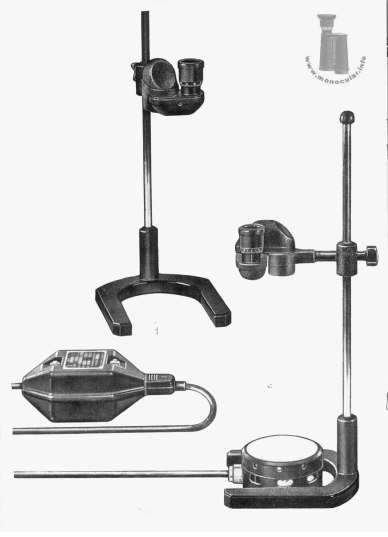
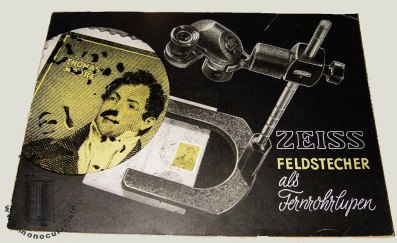
Mit Zusatznahlinsen lässt sich das Turmon für höhere Vergrößerungen umwandeln, dadurch werden natürlich auch kürzere Sehdistanzen bedingt (s. Tabelle bei Docter). Es gab auch UV- und Polarisationsfilter für das Okular. |
Additional close-up lenses increase its magnification, resulting in nearer focussing distances (see table at Docter). There also were filter caps for the eye piece. |
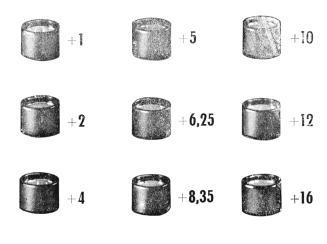
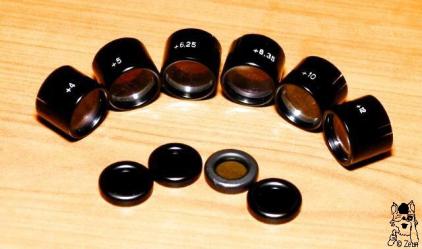
| Um das Turmon als Fernrohrlupe bzw. Mikroskop nutzen zu können, gab es sowohl vor als auch nach dem Krieg Stative mit Klemmvorrichtung (500g), und zur DDR-Zeit einen Leuchttisch (160g) mit Trafo (710g) für Durchlichtuntersuchungen. Die Fotos zeigen zunächst ein Vorkriegsstativ, dann VEB Carl Zeiss Jena Modelle (schwarz mit Hufeisenfuß und grau); die Klemmvorrichtung des schwarzen Stativs lässt sich auch waagerecht schwenken, so dass das Stativ auch für Beobachtungen in der Ferne nutzbar war. In den 1950er Jahren gab es kurzzeitig eine größere Klemmvorrichtung mit einem Drehgelenk zum waagerechten Schwenken und einer innen liegenden Federklemme für den Stativstab, die sich durch Drücken des Knopfes lösen ließ. |
To use the Turmon as a telescopic magnifier or microscope, Zeiss produced stands with clamp holders (500g) and light tables (160g) with a transformer (710g) for microscopic inspections. The photos show firstly a pre-war stand, then VEB Carl Zeiss Jena stands (black with U-shaped foot, and grey one. The clamp of the black model can be turned unto a horizontal position for viewing distant things on the stand. For a short period in the 1950s a bigger mounting clamp was supplied. The clamp had a rotating head for horizonbtal tilting, a spring inside to press it onto the rod of the stand which can be losened by pushing the knob. |
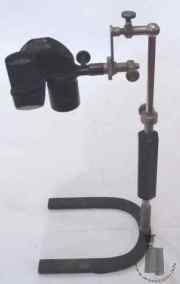
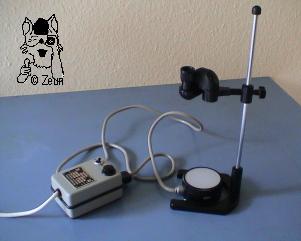
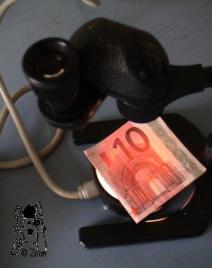
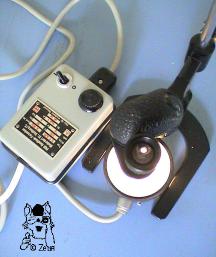
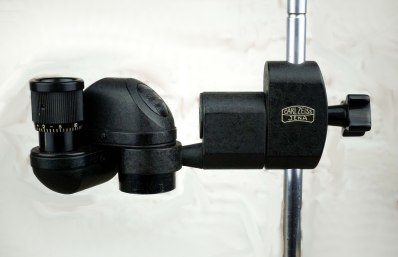
| Eine Sonderkonstruktion aus DDR-Zeiten wahrscheinlich für die NVA (Nationale Volksarmee) ist das "JG 552", bei dem an das Turmonopbjektiv ein Stahltubus mit Auszug angebracht ist. Offenbar steht "JG" für justierglas und diente zum geraden Ausrichten und Kontrollieren von Waffenläufen o.ä.. Die Gesamtlänge ist 36cm eingezogen bzw. 55cmn ausgezogen. Das FG552 hatte einen Transportbehälter aus Holz. Das Turmon wurde auch von VEB-Zeiss Jena für die zweite graue Version des Spiegel-Stereoskops als Vergrößerungsaufsatz angeboten. Jeweils ein Paar Turmons mit Adapterhülse wurde als binokularer Aufsatz verwendet. Es liegt auch eine baugleiche Stereoskopversio naus den 1990er Jahren mit den Docter Faltmonokualren vor. |
A special version from GDR times, probably made for the NVA (= National People'S Army) is the "JG552", which has a telesocpic steel tube attached to the objective end of the Turmon. "JG" stands for "Justierglas" which means a sort of bore-sight to check straightness of gun barrels. Overall length is closed 36cm, and extended 55cm. The JG552 came with a wooden box. The Turmon was also supplied by VEB-Zeiss Jena as magnifying telescopes for their second grey mirror stereoscope version. A pair of Turmons with adapter tubes were used as a binocular attachment. The Docter folding monoculars were also supplied with a later 1990s stereoscope of the same construction. |
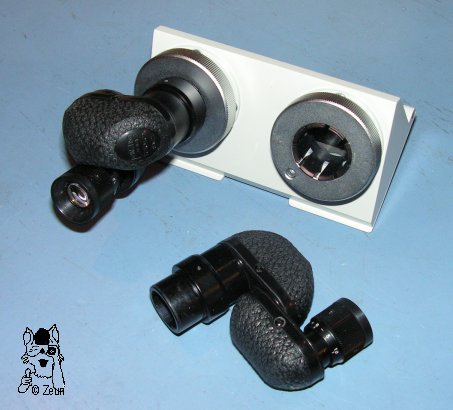
Der Nachfolger ist das Faltmonokulare von Docter (Fa. Jena Analytik). Weitere Infos auch unter Carl Zeiss Katalog MED3 von 1938, S. 5 |
The Turmon's successor is the "Docter" folding monocular by "Jena Analytik". The Lan Optics version still comes close to the original Turmon design. Further information, see Carl Zeiss Catalog MED3 1938, p. 5 |
Fotos: Zeun/Ebay-Auktion


